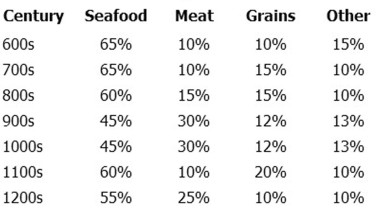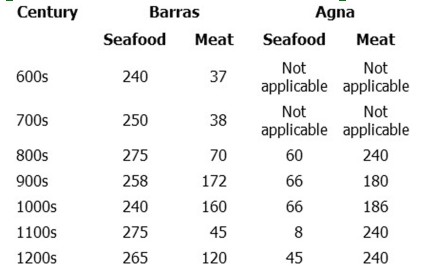GMAT Integrated Reasoning
Home > GMAT Test > GMAT Integrated Reasoning Questions
Next steps
- Use your browser's back button to return to your test results.
- Do more GMAT Integrated Reasoning Questions.
Source: Other
Level: 0
Village Sites
An archaeological team has been excavating three ancient village sites—Barras, Agna, and Cussaia—looking in particular at kitchen waste dumps as a way to understand the villages' dietary patterns and trading relationships. What follows are brief summaries of their findings.
Barras: The best data come from stratified finds in this oceanside village, which was inhabited from AD 600 to 1300 and was the only one of the three villages to produce seafood, its main dietary item. Though Barras residents hunted on land and raised crops, this provided relatively small amounts of food. As Barras's overall prosperity rose, there was more food available per person, and its population increased from an average of 100 residents in the AD 600s to 400 residents in the AD 1000s to 600 residents in the AD 1200s.
Agna: Agna was established in an inland forest around AD 800 and its residents mainly hunted but also ate considerable amounts of fruit, nuts, and other forest-vegetable products. They also traded meat to Barras for other goods. With no open fields, Agna grew no grain.
Cussaia: Predating Barras, Cussaia depended heavily on raising grain crops and eventually obtained seafood and meat via trade. It traded directly only with Barras, because a mountain range separated it from Agna, though some products may have been traded between Agna and Cussaia via Barras.
Additionally, there is no evidence that any other village traded with Barras, Agna, or Cussaia prior to AD 1300.
Food Variety
Barras: Percentages, by Estimated Weight, of Dietary Items Consumed per Person per Month
Food Consumption
Barras, Agna: Estimated Average Monthly Meat and Seafood Consumption (lb per 4-Person Family)
Assume that any increase of 5% or more from one century to the next in the amount of a given food consumed by Barras residents is due primarily to a corresponding increase in imports of that food into Barras from other villages. Given this assumption and the information provided, for each of the following, select Yes if it describes a food likely imported by Barras during times of increased food consumption. Otherwise select No.
| Yes | No | |
|---|---|---|
| Meat from Agna from the AD 500s to the AD 600s | ||
| Meat from Agna from the AD 800s to the AD 900s | ||
| Grain from Cussaia from the AD 600s to the AD 700s |
